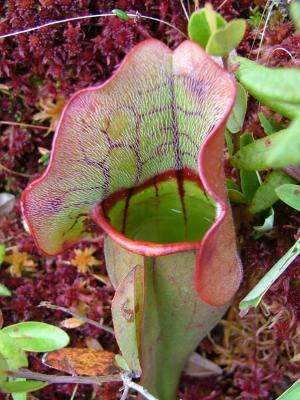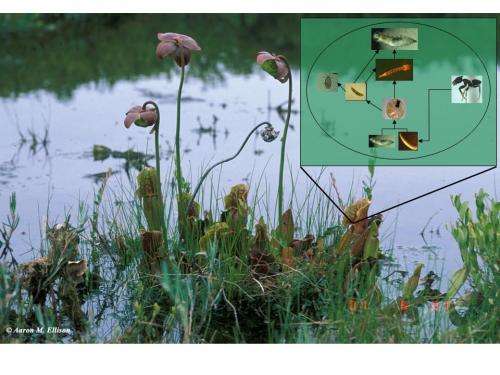An inside look at carnivorous plants: Researchers track the importance of microscopic inhabitants

(Phys.org) —When we imagine drama playing out between predators and prey, most of us picture stealthy lions and restless gazelle, or a sharp-taloned hawk latched on to an unlucky squirrel. But Ben Baiser, a post-doctoral fellow at the Harvard Forest and lead author of a new study in Oikos, thinks on a more local scale. His inter-species drama plays out in the humble bogs and fens of eastern North America, home to the carnivorous pitcher plant, Sarracenia purpurea. "It's shocking, the complex world you can find inside one little pitcher plant," says Baiser.
A pitcher plant's work seems simple: their tube-shaped leaves catch and hold rainwater, which drowns the ants, beetles, and flies that stumble in.
But the rainwater inside a pitcher plant is not just a malevolent dunking pool. It also hosts a complex system of aquatic life, including wriggling mosquito, flesh fly, and midge larvae; mites; rotifers; copepods; nematodes; and multicellular algae. These tiny organisms are crucial to the pitcher plant's ability to process food. They create what scientists call a 'processing chain': when a bug drowns in the pitcher's rainwater, midge larvae swim up and shred it to smaller pieces, bacteria eat the shredded pieces, rotifers eat the bacteria, and the pitcher plant absorbs the rotifers' waste.
But that's not the whole story. Fly larvae are also eating the rotifers, midge larvae, and each other, and everybody eats bacteria. It's a complex food web that shifts on the order of seconds.

Aaron Ellison, a co-author on the new study and senior ecologist at the Harvard Forest, says the pitcher plant food web is an ideal model for understanding larger food webs—with top predators like wolves—that change over a longer period of time. He points out, "With pitcher plants, you can hold the whole food web in your hand. The vast number of pitcher plants in one bog provide endless opportunities for detailed experiments on how food webs work, not only in pitcher plants, but also in bigger ecosystems that are harder to manipulate, like ponds, lakes, or oceans."
With funding from the National Science Foundation, the research team traveled to bogs in British Columbia, Quebec City, and Georgia—the full extent of the plant's range—to analyze the aquatic food webs from 60 pitcher plants. They found 35 different types of organisms inside, with a large contingent of bacteria counting as just one type. Then, says Baiser, "We wanted to know: how did we get different food webs in individual pitchers from the same species pool? What caused these food webs to form the way they did?"
A few well-established scientific models predict how food webs form based on a ranked system of ecosystem factors. For the Oikos study, Baiser and his team checked their real-world observations against those models. He explains: "Say you've got a bunch of lakes. And you've got a big bucket holding all the species that can live in those lakes. When you dump out the bucket, which creatures end up in which lake? What matters more: the size of the lake, or the fact that predator species X is there, too? Or is it random? Those models help us tease those factors apart."
According to the Oikos study, the way pitcher plant food webs assemble is not random. In fact, it seems the predator-prey interactions are of key importance. "You take out one species, and that affects everything else," says Baiser.
More information: April 2013 Oikos paper: Predicting food-web structure with metacommunity models: harvardforest.fas.harvard.edu/ … les/baiser_oikos.pdf
Journal information: Oikos
Provided by Harvard University



















